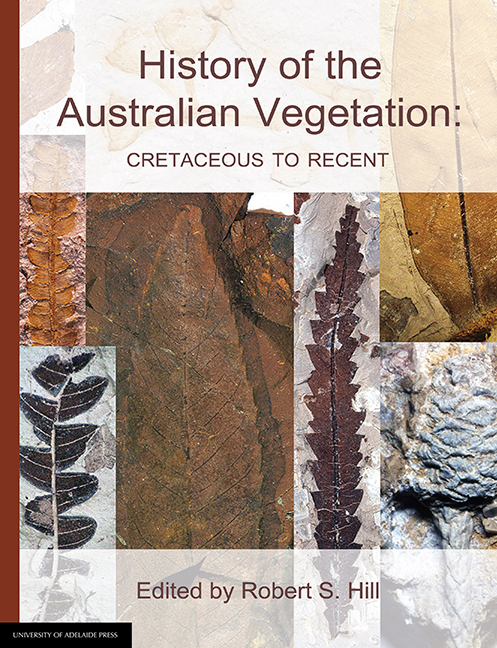Book contents
- Frontmatter
- Contents
- List of contributors
- Introduction to the 2017 edition
- 1 The Australian fossil plant record: an introduction
- 2 Maps of late Mesozoic-Cenozoic Gondwana break-up: some palaeogeographical implications
- 3 The background: 144 million years of Australian palaeoclimate and palaeogeography
- 4 Palaeobotanical evidence for Tertiary climates
- 5 Landscapes of Australia: their nature and evolution
- 6 Patterns in the history of Australia's mammals and inferences about palaeohabitats
- 7 Australian Tertiary phytogeography: evidence from palynology
- 8 Cretaceous vegetation: the microfossil record
- 9 Cretaceous vegetation: the macrofossil record
- 10 Early Tertiary vegetation: evidence from spores and pollen
- 11 The early Tertiary macrofloras of continental Australia
- 12 Cenozoic vegetation in Tasmania: macrofossil evidence
- 13 The Neogene: a period of transition
- 14 The Oligo-Miocene coal floras of southeastern Australia
- 15 Quaternary vegetation
- 16 The history of selected Australian taxa
- Taxonomic index
- General index
7 - Australian Tertiary phytogeography: evidence from palynology
Published online by Cambridge University Press: 25 July 2017
- Frontmatter
- Contents
- List of contributors
- Introduction to the 2017 edition
- 1 The Australian fossil plant record: an introduction
- 2 Maps of late Mesozoic-Cenozoic Gondwana break-up: some palaeogeographical implications
- 3 The background: 144 million years of Australian palaeoclimate and palaeogeography
- 4 Palaeobotanical evidence for Tertiary climates
- 5 Landscapes of Australia: their nature and evolution
- 6 Patterns in the history of Australia's mammals and inferences about palaeohabitats
- 7 Australian Tertiary phytogeography: evidence from palynology
- 8 Cretaceous vegetation: the microfossil record
- 9 Cretaceous vegetation: the macrofossil record
- 10 Early Tertiary vegetation: evidence from spores and pollen
- 11 The early Tertiary macrofloras of continental Australia
- 12 Cenozoic vegetation in Tasmania: macrofossil evidence
- 13 The Neogene: a period of transition
- 14 The Oligo-Miocene coal floras of southeastern Australia
- 15 Quaternary vegetation
- 16 The history of selected Australian taxa
- Taxonomic index
- General index
Summary
This chapter reconstructs Tertiary vegetation and phytogeography from the fossil spore and pollen record. Plants are constrained by their environment: they cannot grow outside of acceptable environmental limits, and climate is the most important of all environmental factors. For this reason, past distributions are considered in conjunction with the appropriate past climate and other environmental factors that may have been very different from those of today. Some wellestablished phytogeographical hypotheses are discussed in the light of the fossil record.
The palynological record is comprehensive and well suited to this purpose, but it has limitations. Not all pollen preserves as fossils. For example, the Lauraceae, an important Australian family and common in the macrofossil record, is absent from the fossil pollen record. When micro- (spores, pollen) and macrofossil (leaves, flowers, fruit) floras are compared, there is a core of common taxa, but some taxa are restricted to one or the other flora. For example, of the total flora identified in one deposit by Graham & Jarzen (1969), 27% were found as microfossils only and 17% as macrofossils only, with a core of 56% found as both. Furthermore, micro- and macrofossils from six Eocene lenses at Anglesea (Victoria) contain spore and pollen floras that vary somewhat, but are generally similar. However, macrofossil percentages are markedly different between lenses, and include taxa not identified as microfossils (Christophel et al.y 1987). The microfossil assemblage samples a broader area and gives a more general picture of the vegetation, whereas macrofossils present more localised and variable facets. Obviously, if both micro- and macrofossils are studied, a better picture of the vegetation emerges than from either one alone, but this has rarely occurred. It is not always possible to study both in the same deposit. Sediments deep underground are accessible by bores, which is a great advantage, especially in the Australian context where most of the landscape is so flat. Microfossils may be extracted from bore samples which are unsuited for macrofossil recovery.
- Type
- Chapter
- Information
- History of the Australian VegetationCretaceous to Recent, pp. 104 - 142Publisher: The University of Adelaide PressPrint publication year: 2017



